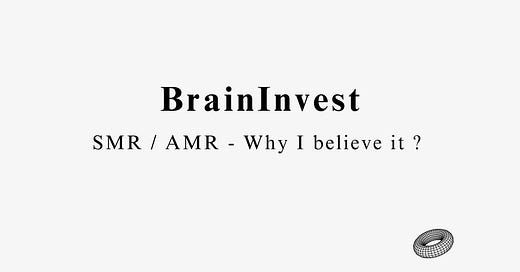SMR / AMR - Why I believe it ?
A big thank you to all those who subscribed. Feel free to share this newsletter with your link to enjoy the gifts !!! 😉
For the past few weeks, I’ve been absolutely obsessed with micro-nuclear reactors - these little technological wonders. Sitting at the intersection of energy innovation and environmental urgency, they have the potential to transform the lives of 685 million people.
But what exactly are they?
A micro-nuclear reactor, as the name suggests, is a small nuclear reactor that produces electricity and/or heat using uranium. We call it "micro" because it produces between 10 to 100 times less energy than a traditional nuclear plant - which, believe it or not, is a huge advantage (more on that later).
There are two main categories: SMRs (Small Modular Reactors) and AMRs (Advanced Modular Reactors). The biggest difference between the two is where they are in terms of development. SMRs are essentially “classic” nuclear reactors, meaning the tech is mature and ready to go. AMRs, on the other hand, are still in R&D, but they have some seriously exciting potential.
Let’s break down the tech
The key differences between these reactors come down to how they cool the atomic fission process and how they transport energy (known as the coolant system).
Main SMR Technologies:
Light Water Reactors (LWRs): The most common and reliable tech. LWRs use high-pressure water as both the moderator and coolant. This makes them super stable and flexible - basically, the most mature option out there.
Boiling Water Reactors (BWRs): Like LWRs, but they use boiling water to generate power. It boosts energy output but makes the cooling process trickier, requiring more precise management.
Advanced Gas-cooled Reactors (AGRs): These stand out by using carbon dioxide as a coolant and graphite as a moderator. Their main application? Industrial heat production.
Modular Fast Reactors (FMRs): They use fast neutrons to increase fuel efficiency and cut down on nuclear waste. Impressive, yes - but they need fancier and more expensive cooling systems to operate.
Main AMR Technologies:
Sodium-cooled Fast Reactors (SFRs): An advanced version of FMRs, SFRs use liquid sodium as a coolant, making them super thermally efficient. They can even burn nuclear waste while maximizing fuel use, and they operate at low pressure, reducing risks.
Molten Salt Reactors (MSRs): These use molten salts as a coolant, and sometimes the fuel is mixed right into the salts. The design is extremely safe in case of leaks and allows for super high operating temperatures, which boosts energy efficiency.
High-Temperature Gas-cooled Reactors (HTGRs): These run at over 800°C, using helium as the coolant, which makes them incredibly efficient for converting heat into electricity. They’re great for industrial use and hydrogen production.
Liquid Metal-cooled Fast Reactors (LMFRs): This tech uses liquid metals like lead or sodium to cool the reactor, making heat transfer crazy efficient, especially at very high temperatures.
In short, each of these technologies has its pros and cons, suited to different needs and available resources.
As for risks, the main ones are leaks during production or equipment wear and tear. But these can easily be managed with strict production standards and monitoring software like Metroscope.
So why aren’t these everywhere yet?
The market for these technologies is massive: emerging countries, remote locations, energy-price-sensitive industries, military bases, research facilities - all of these need a steady, carbon-neutral, and financially stable power source.
That said, these technologies require huge investments, which venture capital has struggled to provide (check out my article on the decline of VC for more on that). To tackle this, the US, Canada, France, China, India, and South Korea have all launched big investment plans for this tech.
What we need now are researchers, entrepreneurs, and political trailblazers to champion these projects. Leaders who can take the waste from our current nuclear plants and turn it into clean, constant, and affordable energy for countries without stable energy infrastructure.
For more on this topic and to learn about the French pioneer making SMRs a reality, check out the latest post by my friend at Objective Net Zero.
Thanks a bunch for reading this far! Feel free to share this edition (and the previous ones) and enjoy lots of perks: stickers, caps, access to events…
Catch you soon!




